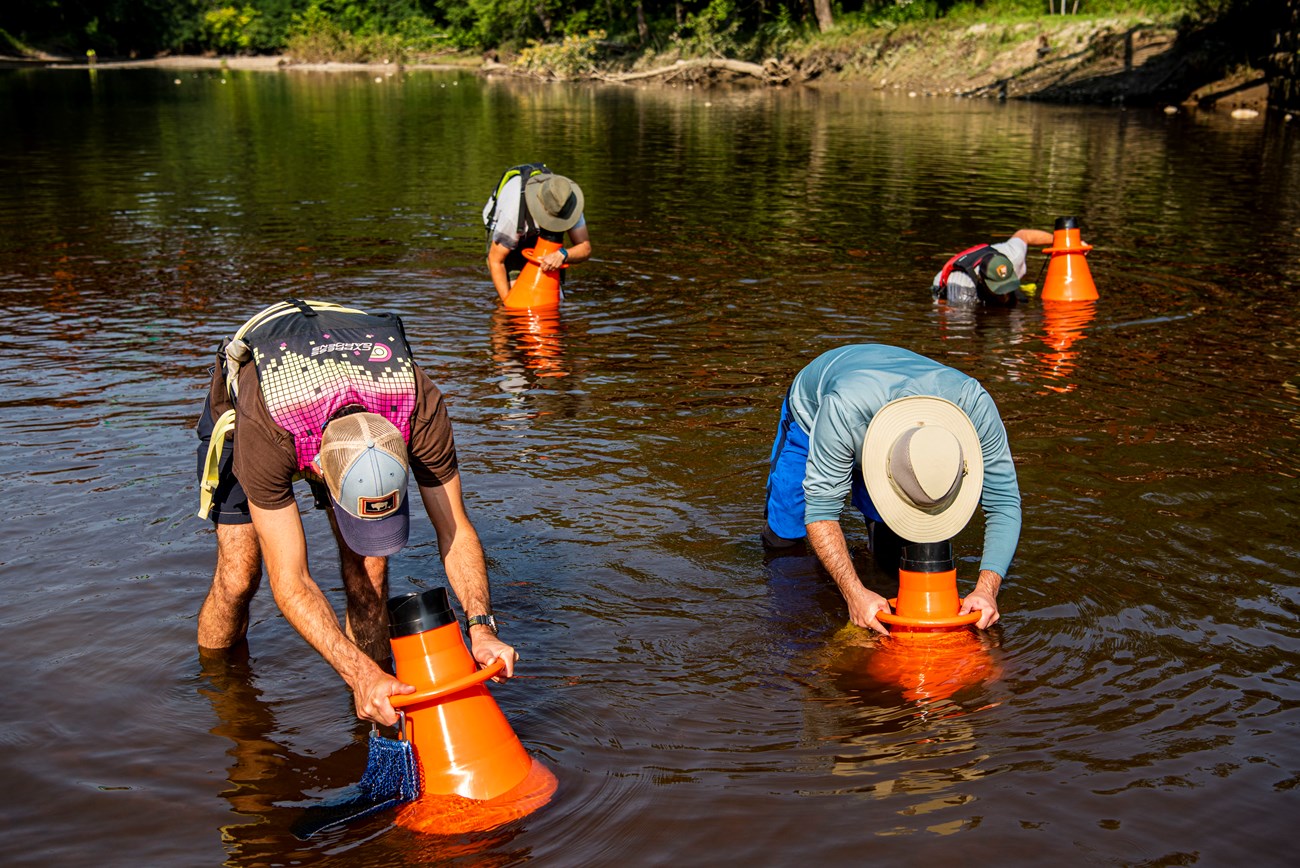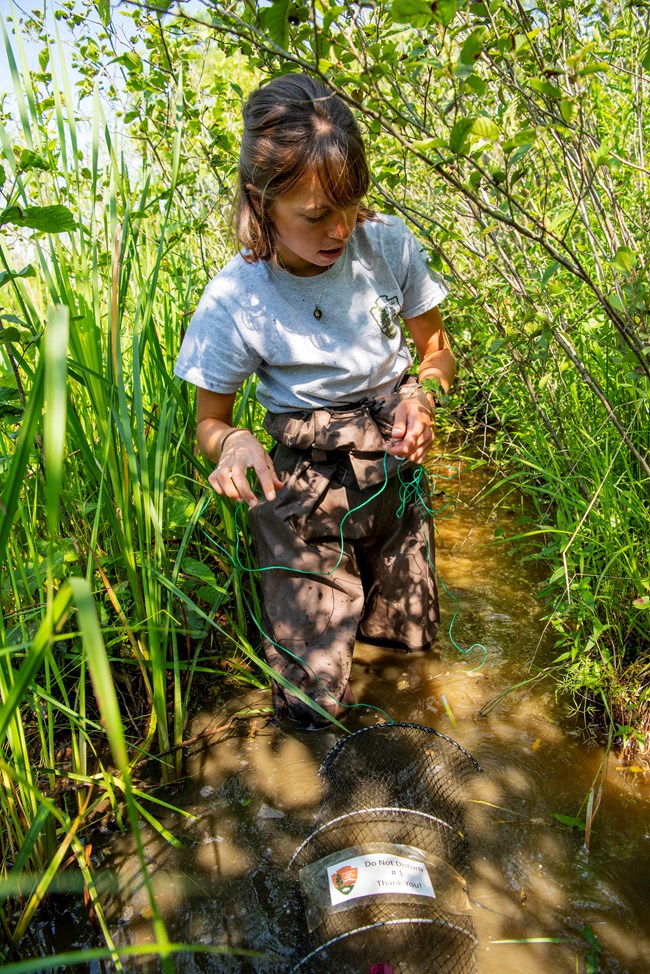Last updated: October 3, 2024
Article
National Park Service Careers: Resource Management
This article is part of a series about National Park Service (NPS) Careers. Visit our Work With Us page to learn more about the different types of work NPS employees do.

NPS / Ryan Grzybowski
Within any national park's boundaries you'll find landscapes, structures, physical objects, and natural processes. Parks are home to many living things, from trees in forests to fish in rivers. They also contain non-living things such as historic buildings, rock formations, and museum artifacts. The NPS refers to all of these objects and structures as park resources.
At Cuyahoga Valley, we call our group of staff who work with these resources the division of Resource Management. Some parks may divide this group into separate Cultural Resources and Natural Resources work groups. At smaller parks, this work may fall under a combined Resource Management and Interpretation group. The common thread through most of these careers is studying, preserving, and restoring the resources of the park.

NPS / Ryan Grzybowski
Managing Park Resources
Every national park is unique. Each was set aside to preserve and protect the specific landscapes, structures, plants, animals, artifacts, and/or stories associated with it. This means each park has specific needs when it comes to resource management.
Some parks protect endangered animal species or communities of rare plants. Some have miles of underground caves or undeveloped seashore. Others preserve historic forts, battlefields, and artifacts from the past. While one park may need an underwater archeologist, another may need a sled dog veterinarian on staff.
Ranger Scientists, Archivists, and Engineers
As you might imagine, there are different kinds of rangers who are experts in studying and managing different kinds of resources. Some are scientists, such as biologists, ecologists, and geologists. Others are archeologists, historians, or archivists. There are even NPS engineers who help preserve, maintain, and sometimes replace infrastructure like bridges, culverts, and facilities. All of these various specialists work together to preserve and protect park resources, while also making them accessible for the enjoyment and education of our visitors.
At Cuyahoga Valley, we have a small staff of resource managers who oversee a lot of different projects. Some work primarily with the park's natural resources: the plants, animals, and ecosystems in the valley. They monitor conditions in the park and work to restore areas that have been polluted or degraded in the past. Other park staff work specifically with our cultural resources: the prehistoric and historic buildings, landscapes, and artifacts. They research the past, provide expert advice on maintenance projects, and manage museum objects and artifacts.
In addition to our own staff, Cuyahoga Valley gets assistance from regional staff who specialize in things like Inventory and Monitoring, archeology, and long-term planning. One example is the Heartland Network. This group of biologists and ecologists help our park and several others to keep track of plant and animal populations over time. Since this group of scientists can assist multiple parks, each of those parks doesn't need to have as many of their own full-time resource managers on their staff.
The NPS also works with other federal, state, and local agencies to accomplish its work. The small staff at Cuyahoga Valley is supported in many ways by our federal partners from U.S. Fish & Wildlife Service, U.S. Geological Survey, U.S. Department of Agriculture, and U.S. Army Corps of Engineers, among others.
What Kinds of Careers Are There?
There are several different careers that fall into this category. Some of the common positions include:
- Biological Science Technicians – perform a variety of tasks such as conducting surveys, collecting data, water quality sampling, native plant seed collection, and removing invasive plant species
- Museum Technicians – manage and preserve park collections and archives, including artifacts, historic documents, and photographs
- Biologists, Ecologists, Geologists, Archeologists, etc. – develop plans and seek funding to inventory, monitor, and restore park resources related to their specialty or area of focus
- Engineers, Compliance Officers, Environmental Specialists, etc. – assess, remediate, and report on park resources related to their specialty, and evaluate the impacts of park maintenance and projects on the environment
- Crew Leaders – lead the work of small crews of other resource management employees and volunteers
- Supervisors – supervise and lead other workers; create weekly and annual work schedules; manage special projects; and ensure other employees are trained in safety, equipment use, herbicide use, etc.
What Skills Are Needed?
Resource managers come from various different backgrounds and have different educational journeys. Many are scientists or other professionals who have advanced degrees in specific fields. Some are current students or recent college graduates who work as interns or seasonal employees. Still others have gained specific skills in their field by pursuing hobbies such as birdwatching or gardening.
Being able to identify species, pay attention to details, and collect data can be helpful for anyone hoping to start a career in resource management. As they progress through their career, employees can gain experience in project management and supervision.
A lot of resource managers start their career by doing an internship or signing up for a volunteer position. This is a great way to gain experience working in a park. Learn more about internships and the federal application process on our How to Apply page.
Tags
- cuyahoga valley national park
- ohio
- midwest
- nps careers
- national park service careers
- nps employee
- park ranger
- park staff
- careers
- career exploration
- jobs
- what we do
- what do rangers do
- work with us
- resource management
- resource stewardship and science
- park science
- cultural resource management
- natural resource management
- engineering
- scientists
- inventory and monitoring
- archeology
